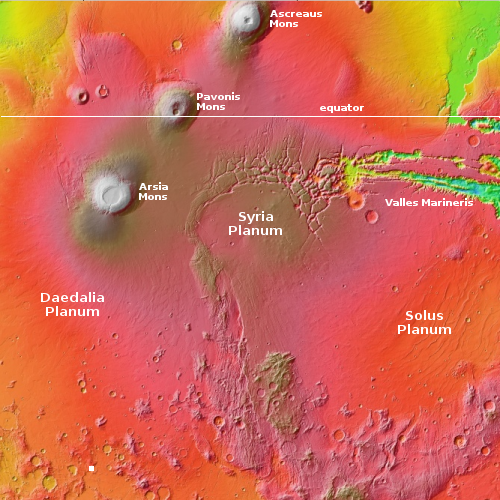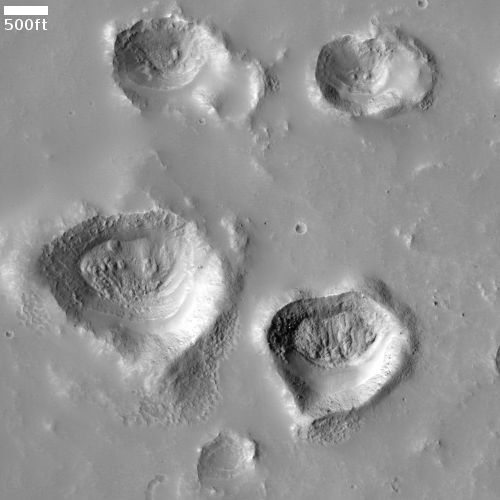Mars: Are these eroding glaciers or impacts in lava?
Cool image time and a mystery! The photo to the right, cropped to post here, was taken on March 29, 2022 by the high resolution camera on Mars Reconnaissance Orbiter (MRO) of an 18-mile-wide crater in the southern cratered highlands of Mars. The full picture, dubbed “Steep Cliff,” was taken apparently to get a good view of the crater’s northern rim. The rim’s steepness suggests that the floor of the crater is significantly filled.
More intriguing however are the scattering of strange depressions about six miles south of the rim. What caused them? The crater’s location is in a part of Mars where it is not unusual to find both glacial features as well as flood plain lava. In fact, the crater’s northeast and southwest rims appear to have been buried by what appears to be flood lava. The northern rim’s shallowness also suggests the crater is well filled with flood lava.
However, the crater is also at 38 degrees south latitude, a latitude where planetary scientists have found lots of glacial features. Much of this crater fill could be glacial.
The overview map below illustrates this mystery.

The white dot in the lower left marks the location of the crater. It sits in the Tharsis Bulge, where Mars’ biggest volcanoes are all located as well as at the southern edge of the giant lava flood plain Daedalia Planum, which had covered everything with lava when those volcanoes were active.
So, are these depressions places where a top layer of glacial ice sublimated away to reveal the flood lava below? The mounds on the floor of these depressions could be lava, as evidenced by other pictures of flood lava elsewhere on Mars.
Maybe instead the depressions are secondary craters from a more recent larger impact nearby. If so, then why are some of these depressions so distorted? Maybe these impacts allowed the upper layer of ice to erode over time, reshaping the craters and also creating traps where more glacial ice could accumulate. The mounds within these depressions — though possibly lava — also resembles glacial features seen in many other mid-latitude craters, adding weight to this theory.
There is no answer yet to these questions, only more questions. We will need to go there to really answer them.
On Christmas Eve 1968 three Americans became the first humans to visit another world. What they did to celebrate was unexpected and profound, and will be remembered throughout all human history. Genesis: the Story of Apollo 8, Robert Zimmerman's classic history of humanity's first journey to another world, tells that story, and it is now available as both an ebook and an audiobook, both with a foreword by Valerie Anders and a new introduction by Robert Zimmerman.
The print edition can be purchased at Amazon or from any other book seller. If you want an autographed copy the price is $60 for the hardback and $45 for the paperback, plus $8 shipping for each. Go here for purchasing details. The ebook is available everywhere for $5.99 (before discount) at amazon, or direct from my ebook publisher, ebookit. If you buy it from ebookit you don't support the big tech companies and the author gets a bigger cut much sooner.
The audiobook is also available at all these vendors, and is also free with a 30-day trial membership to Audible.
"Not simply about one mission, [Genesis] is also the history of America's quest for the moon... Zimmerman has done a masterful job of tying disparate events together into a solid account of one of America's greatest human triumphs."--San Antonio Express-News
Cool image time and a mystery! The photo to the right, cropped to post here, was taken on March 29, 2022 by the high resolution camera on Mars Reconnaissance Orbiter (MRO) of an 18-mile-wide crater in the southern cratered highlands of Mars. The full picture, dubbed “Steep Cliff,” was taken apparently to get a good view of the crater’s northern rim. The rim’s steepness suggests that the floor of the crater is significantly filled.
More intriguing however are the scattering of strange depressions about six miles south of the rim. What caused them? The crater’s location is in a part of Mars where it is not unusual to find both glacial features as well as flood plain lava. In fact, the crater’s northeast and southwest rims appear to have been buried by what appears to be flood lava. The northern rim’s shallowness also suggests the crater is well filled with flood lava.
However, the crater is also at 38 degrees south latitude, a latitude where planetary scientists have found lots of glacial features. Much of this crater fill could be glacial.
The overview map below illustrates this mystery.

The white dot in the lower left marks the location of the crater. It sits in the Tharsis Bulge, where Mars’ biggest volcanoes are all located as well as at the southern edge of the giant lava flood plain Daedalia Planum, which had covered everything with lava when those volcanoes were active.
So, are these depressions places where a top layer of glacial ice sublimated away to reveal the flood lava below? The mounds on the floor of these depressions could be lava, as evidenced by other pictures of flood lava elsewhere on Mars.
Maybe instead the depressions are secondary craters from a more recent larger impact nearby. If so, then why are some of these depressions so distorted? Maybe these impacts allowed the upper layer of ice to erode over time, reshaping the craters and also creating traps where more glacial ice could accumulate. The mounds within these depressions — though possibly lava — also resembles glacial features seen in many other mid-latitude craters, adding weight to this theory.
There is no answer yet to these questions, only more questions. We will need to go there to really answer them.
On Christmas Eve 1968 three Americans became the first humans to visit another world. What they did to celebrate was unexpected and profound, and will be remembered throughout all human history. Genesis: the Story of Apollo 8, Robert Zimmerman's classic history of humanity's first journey to another world, tells that story, and it is now available as both an ebook and an audiobook, both with a foreword by Valerie Anders and a new introduction by Robert Zimmerman.
The print edition can be purchased at Amazon or from any other book seller. If you want an autographed copy the price is $60 for the hardback and $45 for the paperback, plus $8 shipping for each. Go here for purchasing details. The ebook is available everywhere for $5.99 (before discount) at amazon, or direct from my ebook publisher, ebookit. If you buy it from ebookit you don't support the big tech companies and the author gets a bigger cut much sooner.
The audiobook is also available at all these vendors, and is also free with a 30-day trial membership to Audible.
"Not simply about one mission, [Genesis] is also the history of America's quest for the moon... Zimmerman has done a masterful job of tying disparate events together into a solid account of one of America's greatest human triumphs."--San Antonio Express-News



Another great image! Interesting material – notice the very small, very clean, obviously very young craters in the floor material. There’s little or no ejecta, like they were absorbed in soft substrate. And notice the odd-looking, almost serpentine deposit/structure/feature near the foot of the slope. Is it in place? Or something that rolled downslope? Good place for a geology visit!